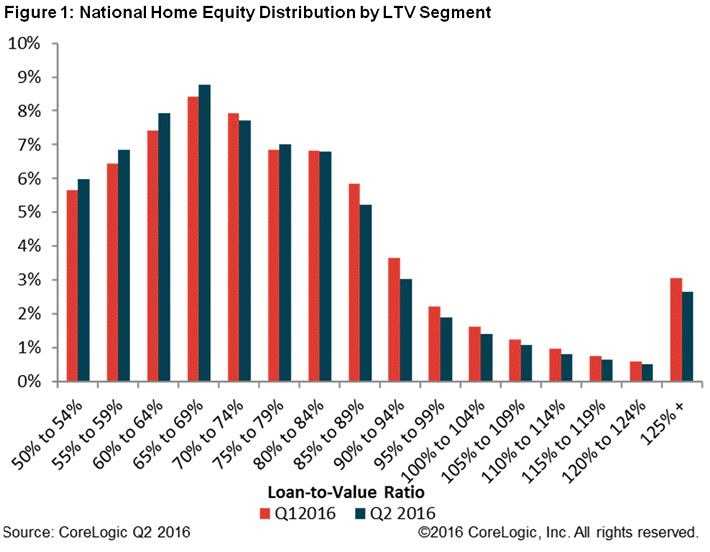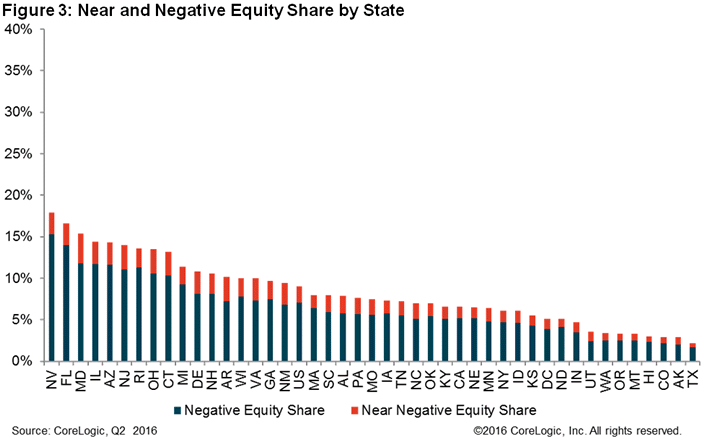More than a half-million fewer homeowners were underwater at the end of the second quarter of 2016 than at the beginning CoreLogic said today. At quarter's end there were approximately 47 million residential properties with positive equity, 92.9 percent of all homes with a mortgage.
The company said the number of properties with negative equity declined by 548,000 during the quarter, but 3.6 million properties are still without equity compared to 4.2 million homes, 8.2 percent of the total, in the first quarter of this year and 4.5 million in the second quarter of 2015 or 8.9 percent. The year over year decrease was 19 percent.
Negative equity applies to borrowers who owe more on their mortgages than their homes are worth. Negative equity can occur because of a decline in home value, an increase in mortgage debt or a combination of both.

The national aggregate value of negative equity was $284 billion at the end of Q2 2016, decreasing approximately $20.4 billion, or 6.7 percent, from $305 billion in Q1 2016. On a year-over-year basis, the value of negative equity declined overall from $314 billion in Q2 2015, representing a decrease of 9.5 percent in 12 months.
Among underwater borrowers, approximately 2.2 million hold only first liens and approximately 1.4 million have both first and second liens or home equity loans. Among those with only a first mortgage the average outstanding balance is $252,000, and they are underwater by an average of $73,000, accounting for $159 billion of the national aggregate. Among those with both first and second liens the average mortgage balance is $314,000 and they were negative by $88,000, a total of $125 billion nationwide.
The value of the equity in all homes with a mortgage grew by over $646 billion nationwide compared to the same quarter in 2015. This is an annual increase of 9.9 percent.
The bulk of positive equity for mortgaged residential properties is concentrated at the high end of the housing market. For example, 96 percent of homes valued at $200,000 or more have equity compared with 89 percent of homes valued at less than $200,000.
Of the more than 50 million homes with a mortgage, approximately 8.6 million, or 17 percent, have less than 20 percent equity (referred to as under-equitied) and approximately 965,000, or 1.9 percent, have less than 5 percent equity (referred to as near-negative equity). Borrowers who are under-equitied may have a difficult time refinancing their existing homes or obtaining new financing to sell and buy another home due to underwriting constraints. Borrowers with near-negative equity are considered at risk of shifting into negative equity if home prices fall.

"Home-value gains have played a large part in restoring home equity," said Dr. Frank Nothaft, chief economist for CoreLogic. "The CoreLogic Home Price Index for the U.S. recorded 5.2 percent growth in the year through June, an important reason that the number of owners with negative equity fell by 850,000 in the second quarter from a year earlier."
"We see home prices rising another 5 percent in the coming year based on the latest projected national CoreLogic Home Price Index," said Anand Nallathambi, president and CEO of CoreLogic. "Assuming this growth is uniform across the U.S., that should release an additional 700,000 homeowners from the scourge of negative equity."
The highest percentage of underwater homes at the end of the second quarter were in Nevada at 15.3 percent, followed by Florida (14 percent), Maryland (11.8 percent), Illinois (11.7 percent) and Arizona (11.6 percent). These top five states combined accounted for 33.7 percent of negative equity in the U.S., but only 18.6 percent of outstanding mortgages.
Texas, Alaska, Colorado, Hawaii, and Utah have the highest percentage of homes with positive equity, all exceeding 97.5 percent.







